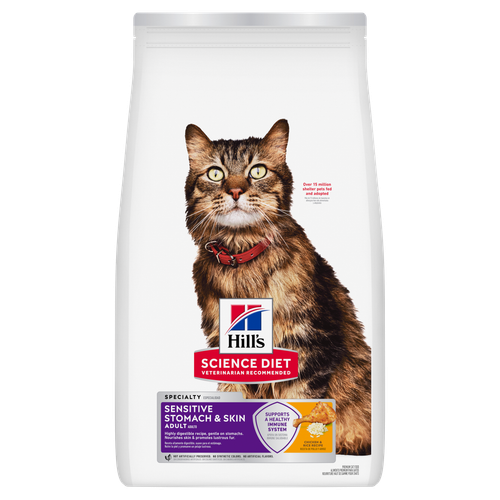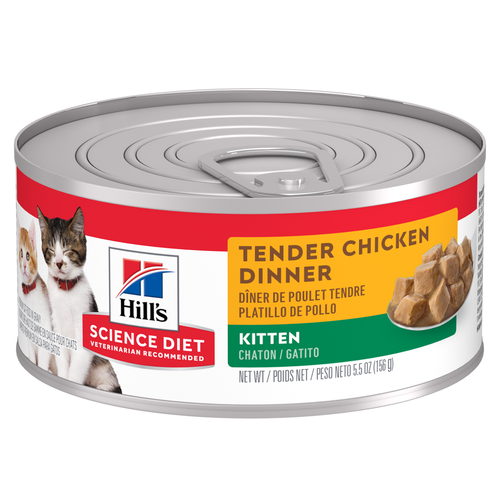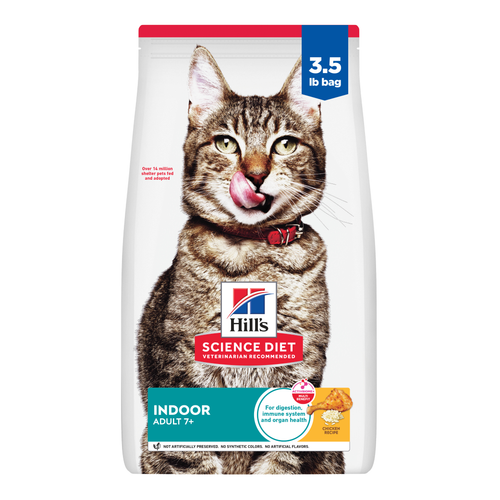
-
Find the right food for your petTake this quiz to see which food may be the best for your furry friend.Find the right food for your petTake this quiz to see which food may be the best for your furry friend.Featured products
 Adult Large Breed Chicken & Barley Recipe Dog Food
Adult Large Breed Chicken & Barley Recipe Dog FoodSupports healthy joints, lean muscle, and beautiful coat for large breed dogs
Shop Now Hill's Science Diet Adult Chicken & Beef Entrée Dog Food
Hill's Science Diet Adult Chicken & Beef Entrée Dog FoodChicken & Beef Entrée in a delicious loaf with complete & balanced nutrition to help keep adult dogs active and healthy
Shop Now Adult Chicken & Barley Recipe Dog Food
Adult Chicken & Barley Recipe Dog FoodSupports lean muscle and beautiful coat for adult dogs
Shop NowFeatured products Hill's Science Diet Adult Sensitive Stomach & Skin Chicken & Rice Recipe Cat Food
Hill's Science Diet Adult Sensitive Stomach & Skin Chicken & Rice Recipe Cat FoodScience-backed nutrition tailored for skin and digestive health, packed with clinically proven, immune system supporting antioxidants.
Shop Now Adult Chicken Recipe Cat Food
Adult Chicken Recipe Cat FoodSupports lean muscle and beautiful fur for adult cats
Shop Now Adult 7+ Senior Vitality Chicken & Vegetable Stew Cat Food
Adult 7+ Senior Vitality Chicken & Vegetable Stew Cat FoodImproves Everyday Ability to Get Up & Go
Shop Now -
Dog
- Dog Tips & Articles
-
Health Category
- Weight
- Food & Environmental Sensitivities
- Urinary
- Digestive
- Joint
- Kidney
-
Life Stage
- Puppy Nutrition
- Adult Nutrition
- Senior Nutrition
Cat- Cat Tips & Articles
-
Health Category
- Weight
- Skin & Food Sensitivities
- Urinary
- Digestive
- Kidney
-
Life Stage
- Kitten Nutrition
- Adult Nutrition
Featured articles The Science Behind Our Love for Pets
The Science Behind Our Love for PetsLearn the scientific reasons why we have such strong connections with our pets, and what science says about the love between humans and our furry friends.
Read More What Is Littermate Syndrome? Pet Adoption Guide
What Is Littermate Syndrome? Pet Adoption GuideLearn more about littermate syndrome in dogs and cats and how to successfully navigate adoption and early socialization processes.
Read More How to Properly Mix Wet & Dry Pet Foods
How to Properly Mix Wet & Dry Pet FoodsAn Orange cat eating from a bowl filled with mixed food
Read More -


High-fiber cat food has become a staple for cats with gastrointestinal issues. But why exactly is fiber important for your furball of a pet?
In plenty of cases, cat food includes fiber to help with digestive functions and benefit the stool quality of cats who might otherwise have digestive upset. High-fiber foods may be beneficial in cases of constipation, diarrhea, diabetes and even obesity.
The Microbiome and It's Interaction With Cat Food With Fiber
The gut microbiome refers to the many millions of microbes (bacteria, protozoa, fungi, viruses) that live inside of cats (as well as dogs, humans and other living creatures) digestive systems This ecosystem of living organisms is fundamental to digestion.
Bacteria in the colon of pets helps to break down indigestible material and produce beneficial compounds like vitamins. Nowhere is the former function more evident than when it comes to breaking down fibers. Bacteria often engage with fibers in a process called fermentation.
Cats, even though they are carnivores, can benefit significantly from consuming a cat food with fiber.

Classifying Fiber in Cat Food
One way to classify dietary fiber is based on solubility. Soluble fibers tend to dissolve in gastric juices and water in the gut and some soluble fibers turn into gels that can hold water, and make stools easier to pass. Insoluble fibers add bulk to the food eaten to help to regulate the transit of foodstuff through the intestines and can help with stool consistency. Both soluble and insoluble fibers can be fermentable. This means that bacteria in the gut can breakdown these fibers and produce new compounds that, for example, can nourish the cells of the colon.
Prebiotics in Cat Food With Fiber
Cat food with fiber typically includes a blend of soluble and insoluble fibers to help promote a healthy gut and good stool quality.. Some of these fiber ingredients are also referred to as prebiotics — ingredients, typically fermentable fibers, that promote the growth of the "good bacteria" that live in the intestines.
Some high-fiber cat foods work specifically because they help feed the beneficial bacteria and promote a balanced microbiome. Plenty of digestive conditions may cause a bacterial imbalance including chronic diarrhea, colitis and constipation.
Other Reasons to Feed High-Fiber Cat Food
Diabetic cats are typically fed high-protein, low-carbohydrate foods but may also benefit from high-fiber cat food if they are prone to becoming overweight or have certain types of GI conditions.. Some fibers slow the absorption of nutrients, allowing the sugars from starches to be absorbed more slowly and therefore stabilizing blood sugar levels. Overweight cats or those prone to weight gain may also benefit from food high in fiber, as it may make them feel more full than regular food — and weight loss may help manage diabetes.
Furthermore, cat food with fiber may also help cats who suffer from GI diseases that affect the large intestine. Fiber can help regulate the motility in the GI tract and manage water balance to avoid the 2 extremes - constipation and diarrhea. Molecules called long-chain fatty acids may be derived from the breakdown of fiber to help nourish the colon.


Tasty Tips
Is High-Fiber Cat Food Natural?
Left to their own devices, cats eat plenty of things humans consider indigestible, like hair, bone, gristle, feathers, fish scales and stomach contents of their prey. Gross, but natural. Some of these are digestible to a point, while others may contain fiber that isuseful for digestion.
While there's a lot about feline nutrition that scientists have yet to understand, they're starting to realize that carnivorous cats actually can benefit from fiber. A study on cheetahs' eating habits published by the Journal of Animal Science found that those who ate whole prey — fur, stomach contents and all — had a more favorable fecal profile than those who ate simple meat. This has led researchers to conclude that carnivore digestive systems must do something useful with all that extra roughage.
The Role of Low-Fiber Cat Food
What if your vet recommends a low-fiber cat food instead? Typically, veterinarians recommend low-fiber food for cats with a sudden onset of GI upset such as vomiting or diarrhea. These foods tend to have higher levels of other nutrients such as electrolytes and B-vitamins to help recovery in these cats. Always consult a veterinarian when selecting a food for your cat. If your cat is on a high-fiber meal plan, their vet should monitor them to make sure their fiber-responsive conditions are well-managed.


Dr. Patty Khuly is an award-winning veterinarian known for her independent thinking, her spirited pet advocacy, her passion for the veterinary profession, and her famously irreverent pet health writing.
Dr. K is an honors graduate of both Wellesley College and the University of Pennsylvania School of Veterinary Medicine. She received her MBA at The Wharton School of Business as part of the prestigious VMD/MBA dual-degree program. She now owns Sunset Animal Clinic, a veterinary practice in Miami, Florida.
Related products

Delectable chunks with tender chicken smothered in a rich gravy

Precisely balanced nutrition with the delicious taste of minced turkey & liver to help fuel the energy needs of cats during the prime of their life

Improves Everyday Ability to Get Up & Go

Supports energy level and beautiful fur in mature indoor cats
Related articles

When you adopt a cat, you don't just gain a best friend; you also save her life. Here's why getting a cat from a local animal shelter makes so much sense.

Learn how to litter train a kitten with this guide to potty training, including when to start litter training kittens and troubleshooting tips.

Discover how to train your cat, starting with very basic first steps that both reward good behavior and discourage the bad.

Discover which cat toys games your feline friend might like, and how they are great sources of exercise. Explore our library of articles to learn more.

Put your cat on a diet without them knowing
Our low calorie formula helps you control your cat's weight. It's packed with high-quality protein for building lean muscles, and made with purposeful ingredients for a flavorful, nutritious meal. Clinically proven antioxidants, Vitamin C+E, help promote a healthy immune system.
Put your cat on a diet without them knowing
Our low calorie formula helps you control your cat's weight. It's packed with high-quality protein for building lean muscles, and made with purposeful ingredients for a flavorful, nutritious meal. Clinically proven antioxidants, Vitamin C+E, help promote a healthy immune system.

